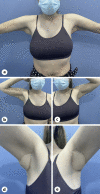Parascapular Flap for Severe Hidradenitis Suppurativa
- PMID: 38188892
- PMCID: PMC10769502
- DOI: 10.1159/000533387
Parascapular Flap for Severe Hidradenitis Suppurativa
Abstract
Hidradenitis suppurativa is a chronic inflammatory disease which affects apocrine glands and hair follicles of the skin, primarily in the axillary and groin regions. This condition can be highly debilitating, causing painful lesions and a negative psychological impact on patients. While medical and minimally invasive treatments are available, surgical intervention may be necessary for severe cases. In cases involving axillary defects, the use of local flaps such as the parascapular flap is a viable option. In this case report, we present a 34-year-old woman who presented to our clinic with a history of recurrent abscesses and cutaneous infections in the axillary region. After thorough evaluation, we chose to use the parascapular flap for reconstruction. The parascapular flap is a one-stage procedure that allows for extensive resection of the axillary area without resulting in contractions or retractions over the long term. Additionally, this technique allows for preservation of the axilla's original shape with minimal donor site morbidity.
Keywords: Hidradenitis suppurativa; Parascapular flap; Reconstructive surgery.
© 2024 The Author(s). Published by S. Karger AG, Basel.
Conflict of interest statement
The authors have no conflicts of interest to declare.
Figures



Similar articles
-
Reconstruction of the Axillary Region after Excision of Hidradenitis Suppurativa: A Systematic Review.Indian J Plast Surg. 2022 Dec 11;56(1):6-12. doi: 10.1055/s-0042-1758452. eCollection 2023 Feb. Indian J Plast Surg. 2022. PMID: 36998929 Free PMC article. Review.
-
Reconstruction of axillary defects with propeller parascapular flap after resection in patients with advanced hidradenitis suppurativa.Wounds. 2022 Oct;34(10):245-249. doi: 10.25270/wnds/21058. Wounds. 2022. PMID: 36219710
-
Two Cases of Hidradenitis Suppurativa Treated with Adalimumab at the Department of Dermatology and Venereology, Clinical Hospital Mostar.Acta Dermatovenerol Croat. 2021 Jul;29(2):108-110. Acta Dermatovenerol Croat. 2021. PMID: 34477078
-
Immediate and Delayed Reconstruction after Excision of Axillary Hidradenitis Suppurativa Using a Propeller Flap.Plast Reconstr Surg Glob Open. 2019 Aug 12;7(8):e2387. doi: 10.1097/GOX.0000000000002387. eCollection 2019 Aug. Plast Reconstr Surg Glob Open. 2019. PMID: 31592019 Free PMC article.
-
[Ultrasound examination of hidradenitis suppurativa].Actas Dermosifiliogr. 2015 Nov;106 Suppl 1:49-59. doi: 10.1016/S0001-7310(16)30007-2. Actas Dermosifiliogr. 2015. PMID: 26895939 Review. Spanish.
References
-
- Plastic surgical management of hidradenitis suppurativa. United States; 2021. - PubMed
-
- Hurley HJ. Hidradenitis Suppurativa. Roenigk & Roenigk’s dermatologic surgery: principles and practice. 2nd ed. New York, NY: CRC press; 1996. p. 623–45.
-
- Zouboulis CC, Tzellos T, Kyrgidis A, Jemec GBE, Bechara FG, Giamarellos-Bourboulis EJ, et al. . Development and validation of the International Hidradenitis Suppurativa Severity Score System (IHS4), a novel dynamic scoring system to assess HS severity. Br J Dermatol. 2017;177(5):1401–9. - PubMed
-
- Slade DEM, Powell BW, Mortimer PS. Hidradenitis suppurativa: pathogenesis and management. Br J Plast Surg. 2003;56(5):451–61. - PubMed
-
- Soldin MG, Tulley P, Kaplan H, Hudson DA, Grobbelaar AO. Chronic axillary hidradenitis--the efficacy of wide excision and flap coverage. Br J Plast Surg. 2000;53(5):434–6. - PubMed
Publication types
LinkOut - more resources
Full Text Sources

